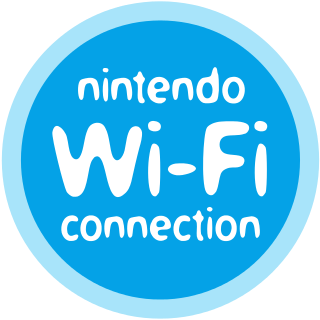
IEEE 802.11 is part of the IEEE 802 set of local area network (LAN) technical standards, and specifies the set of medium access control (MAC) and physical layer (PHY) protocols for implementing wireless local area network (WLAN) computer communication. The standard and amendments provide the basis for wireless network products using the Wi-Fi brand and are the world's most widely used wireless computer networking standards. IEEE 802.11 is used in most home and office networks to allow laptops, printers, smartphones, and other devices to communicate with each other and access the Internet without connecting wires. IEEE 802.11 is also a basis for vehicle-based communication networks with IEEE 802.11p.

A personal digital assistant (PDA), also known as a handheld PC, is a multi-purpose mobile device which functions as a personal information manager. PDAs have been mostly displaced by the widespread adoption of highly capable smartphones, in particular those based on iOS and Android, and thus saw a rapid decline in use after 2007.

Worldwide Interoperability for Microwave Access (WiMAX) is a family of wireless broadband communication standards based on the IEEE 802.16 set of standards, which provide physical layer (PHY) and media access control (MAC) options.
Archos is a French multinational electronics company that was established in 1988 by Henri Crohas. Archos manufactures tablets, smartphones, portable media players and portable data storage devices. The name is an anagram of Crohas' last name. Also, in Greek (-αρχος), it's a suffix used in nouns indicating a person with power. The company's slogan has been updated from "Think Smaller" to "On The Go", and the current "Entertainment your way".
Mobile content is any type of web hypertext and information content and electronic media which is viewed or used on mobile phones, like text, sound, ringtones, graphics, flash, discount offers, mobile games, movies, and GPS navigation. As mobile phone use has grown since the mid-1990s, the usage and significance of the mobile devices in everyday technological life has grown accordingly. Owners of mobile phones can now use their devices to make photo snapshots for upload, twits, mobile calendar appointments, and mostly send and receive text messages, listen to music, watch videos, take mobile pictures and make videos, use websites to redeem coupons for purchases, view and edit office documents, get driving instructions on mobile maps and so on. The use of mobile content in various areas has grown accordingly.

Nintendo Wi-Fi Connection was an online multiplayer gaming service run by Nintendo to provide free online play in compatible Nintendo DS and Wii games. The service included the company's Wii Shop Channel and DSi Shop game download services. It also ran features for the Wii and Nintendo DS systems.

Windows SideShow was a feature by Microsoft introduced in Windows Vista to supply information such as e-mail, instant messages, and RSS feeds from a personal computer to a local or remote peripheral device or display. SideShow was intended to enhance the Windows experience by enabling new mobility scenarios for the Windows platform and by providing power saving benefits as part of Microsoft's broader efforts regarding a mobile initiative.

A digital photo frame is a picture frame that displays digital photos without the need of a computer or printer. The introduction of digital photo frames predates tablet computers, which can serve the same purpose in some situations; however, digital photo frames are generally designed specifically for the stationary, aesthetic display of photographs and therefore usually provide a nicer-looking frame and a power system designed for continuous use.

My Life Online (Mylo) was a device created and marketed by Sony for portable instant messaging and other Internet-based communications, browsing Internet web sites using the Opera web browser and playback and sharing of media files. The pocket-sized, tablet-shaped handheld device, which debuted in 2006, had a screen which slid up to reveal a QWERTY keyboard. The brand name 'Mylo' means My Life Online. Using Wi-Fi instead of cellular networks, the Mylo was targeted to the 18–24 age group.

Kin was a short-lived mobile phone line from Microsoft designed for users of social networking. The phones, aimed at people between ages 15 and 30, were manufactured by Sharp Corporation and sold through Verizon Wireless.
Wi-Fi Direct is a Wi-Fi standard for peer-to-peer wireless connections that allows two devices to establish a direct Wi-Fi connection without an intermediary wireless access point, router, or Internet connection. Wi-Fi Direct is single-hop communication, rather than multi-hop communication like wireless ad hoc networks.

The O2 Joggler is a computing appliance which was sold by O2 in the United Kingdom. Manufactured by OpenPeak and based on their OpenFrame product, the Joggler's main selling point was its shared calendar application and was aimed at organising family life. It was marketed under the slogan "Your new fridge door".

Wireless Display (WiDi) is technology developed by Intel that enables users to stream music, movies, photos, videos and apps without cables from a compatible computer to a compatible HDTV or through the use of an adapter with other HDTVs or computer monitors. Intel WiDi supports HD 1080p video quality, 5.1 surround sound, and low latency for interacting with applications sent to the TV from a PC.

Android Froyo is the sixth version of Android and is a codename of the Android mobile operating system developed by Google, spanning versions between 2.2 and 2.2.3. Those versions are no longer supported.
Miracast is a wireless communications standard created by the Wi-Fi Alliance which is designed to transmit video and sound directly from devices to display receivers. It can roughly be described as "HDMI over Wi-Fi", replacing cables in favor of wireless. The protocol is utilised in many devices and is used or branded under various names by different manufacturers, including Smart View and AllShare Cast, SmartShare, screen mirroring, Cast, wireless display and screen casting.
Microsoft mobile services are a set of proprietary mobile services created specifically for mobile devices; they are typically offered through mobile applications and mobile browser for Windows Phone platforms, BREW, and Java. Microsoft's mobile services are typically connected with a Microsoft account and often come preinstalled on Microsoft's own mobile operating systems while they are offered via various means for other platforms. Microsoft started to develop for mobile computing platforms with the launch of Windows CE in 1996 and later added Microsoft's Pocket Office suite to their Handheld PC line of PDAs in April 2000. From December 2014 to June 2015, Microsoft made a number of corporate acquisitions, buying several of the top applications listed in Google Play and the App Store including Acompli, Sunrise Calendar, Datazen, Wunderlist, Echo Notification Lockscreen, and MileIQ.

The Samsung Galaxy Grand is a smartphone developed by Samsung Electronics, first announced on December 18, 2012. The phone has a dual core Cortex-A9 1.2 GHz processor and a RAM of 1 GB, with an internal memory of 8 GB which can be extended to another 64 GB by use of microSD cards. The device also supports internet connectivity through 2G and 3G, apart from Wi-Fi. Navigation systems including A-GPS and GLONASS with Google Maps. The phone runs on the Android 4.1.2 Jelly Bean OS, with Samsung releasing updates up to 4.2.2. However, custom ROMs are available up to Android 7.1.2 Nougat.

The Nokia Asha 310, also known as the Nokia Asha 3010 or the Nokia ASHA 310 RM-911, was released in March 2013. It is the first in the line of the Asha range of phones to have dual subscriber identity module (SIM) slots and Wi-Fi connectivity. It was a reinvention of the Asha range to remain competitive with new Android devices. It cost $102.00 at its launch date. It has a touchscreen, comes with either a 2 or 4 GB micro SD card, and has 64 MB of RAM, a 2 MP camera and a battery that can last up to 600 hours in standby mode. The phone can play music for up to 54 hours or video for up to 9.5 hours, and has a maximum of 17 hours talk time (2G).
Comparison of user features of messaging platforms refers to a comparison of all the various user features of various electronic instant messaging platforms. This includes a wide variety of resources; it includes standalone apps, platforms within websites, computer software, and various internal functions available on specific devices, such as iMessage for iPhones.













